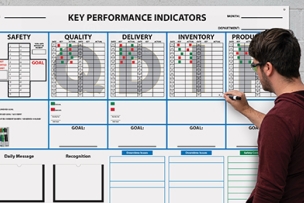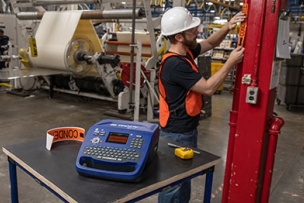Although California has a wildfire standard, no equivalent federal standard exists, so it’s worth looking at how companies across North America can protect employees from the potentially harmful health effects of inhaling wildfire smoke.
Read more: PPE Selection: Find the Right Type of Respirator
Health Effects of Air Pollution
Wildfire smoke is a mixture of gases and fine particles from burning trees, plants, buildings and other material.
Breathing in this smoke can produce harmful health effects, and it can have a particularly negative impact on people who have preexisting health conditions and those who are sensitive to air pollution.
Fine particulate matter, or very fine particles in the air under 2.5 microns in diameter, is the main component of wildfire smoke that affects public health.
These small particles, which are also referred to as “PM2.5,” can be “inhaled into the deepest recesses of the lungs and may enter the bloodstream impairing vital organs including the lungs,” according to a research paper in Nature Communications. These particles can lead to maladies such as bronchitis or the worsening of respiratory conditions such as asthma and emphysema.
Guidance from OSHA and the CDC
With large fires also reported in Alaska, Idaho, Oregon and Washington, burning thousands of acres of land and releasing large amounts of smoke into the atmosphere, the Occupational Safety and Health Administration (OSHA) has provided information about how to protect employees working in areas where this smoke may be a concern:
- OSHA’s Preparedness page provides information on evacuation plans, safety zones around buildings, and equipment to have on hand in case of a wildfire. Preparing plans in advance can help workers get to safety before a wildfire affects an area and also can help protect personal property.
- OSHA’s Response/Recovery page details hazards that may be present in areas affected by wildfires. These include safety hazards such as unstable structures, heavy equipment, and slips, trips and falls; and health hazards such as heat stress, hazardous materials and carbon monoxide.
The Centers for Disease Control and Prevention (CDC) offers a fact sheet with useful information to reduce hazards related to indoor and outdoor smoke at work or home environments.
The CDC also offers procedures to reduce exposures to smoke when necessary.
If workers must be in areas with high levels of smoke, especially for long periods, or if a worker is sensitive to wildfire smoke and says their health or safety is negatively affected by smoke exposure, the following steps can help to reduce that exposure, the CDC advises:
- Frequently monitor air quality conditions in the area by visiting the Environmental Protection Agency’s U.S. fire and smoke interactive map or your state health department’s air quality website.
- Relocate or reschedule work tasks to smoke-free or less smoky areas or times of the day.
- Reduce levels of physical activity, especially strenuous and heavy work.
- Require and encourage workers to take frequent breaks in places that are free from smoke.
Types of Respiratory Protection for Wildfires
Although simple cloth face coverings may help to block some particulate matter, they are not robust enough to protect lungs from dangerous air particles.
Speaking in a recent webinar on respiratory protection in the workplace hosted by safety consultancy J. J. Keller & Associates, Environmental Health and Safety Senior Editor Mark Stromme emphasized the importance of selecting the appropriate PPE for respiratory protection.
Stromme noted that there are three primary types of respiratory devices that employers can use for wildfire smoke.
- N95 respirators, which are disposable and approved by the National Institute for Occupational Safety and Health, offer some protection. These masks should be used with caution, however, as they only protect when fitted correctly, and fit testing should be performed by an individual who is trained in the practice. What’s more, these respirators don’t offer any eye protection.
- Reusable half-face respirators come with replaceable cartridges and adjustable straps. They cover more surface area of the head and therefore offer a more secure fit.
- Reusable full-face respirators cover more of the face for a better fit. They protect the eyes and come with replaceable filter cartridges.
Each option has limitations, such as lack of eye protection or imperfect protection against some gases or vapors, Stromme says, adding that it’s worth contacting your local fire department for advice on the best protection for your area.
Employees should undergo a health assessment to determine whether they are medically fit to wear a respirator on the job. The assessment helps to protect employees’ health at work and ensures workplace compliance with OSHA’s respiratory protection standards.
Read more: Why Do Disposable Respirators Have a Defined Shelf Life?
Proper Respirator Maintenance
Also discussed in the J. J. Keller webinar: the proper care and maintenance of reusable respirators, which is essential for their correct operation and effectiveness. A respirator needs to be cleaned to remove contamination and prevent irritation for the user.
Inspection procedures may include:
- Checking the respirator’s facepiece for cracks or tears, which may impair the user’s vision, or signs that the seal is distorted or damaged.
- Looking for damage or dirt on the inhalation and exhalation valves.
- Making sure that head straps are intact and have good elasticity.
- Examining all plastic parts for signs of cracking and inspecting filter gaskets or seals to make sure they are in good condition.
When it comes to cleaning respirators, J. J. Keller recommends taking apart the PPE and going through this process:
- Clean and sanitize the respirator, using cleaning products recommended by the respirator’s manufacturer. Use alcohol-free wipes, or warm water (less than 110 degrees Fahrenheit) and a mild disinfectant or detergent free of lanolin or oils. Scrub the respirator’s parts with a soft brush or sponge, taking care to not scratch the lenses.
- Rinse thoroughly in fresh warm water to prevent detergent residue from drying out skin or causing dermatitis. Some detergents can deteriorate rubber parts or corrode metal parts if not rinsed completely.
- Allow components to air-dry, or lightly pat them dry with a soft towel. Do not use heaters or bright sunlight to dry the respirator, as it may cause damage.
- Reassemble the respirator and inspect it, replacing filters, cartridges or other parts as needed.
- Once cleaned and inspected, store the respirator, making sure to keep it away from sunlight, dust, extreme temperatures, moisture or damaging chemicals.
Following these guidelines will help keep your respirators in good working order for longer, potentially saving you from serious injury in a dangerous work situation.
What measures are you taking to protect your workers from unhealthy air? Share your thoughts and insights in the comments below.





Talk to Us!
Leave a reply
Your email address will not be published. Required fields are marked *